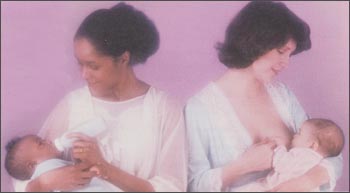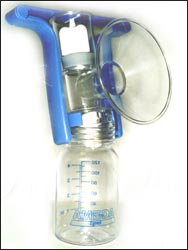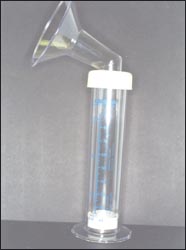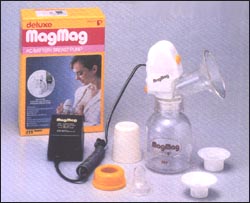
- 모유는 아기에게 가장 좋은 자연 음식물이다. 생후 6개월까지 엄마의 젖만 먹여 아기를 키워도 아기들은 충분한 영양분과 수분, 면역체 등을 모유에서 섭취해 정상적으로 잘 자랄 수 있다.
생후 6개월 이후부터 모유만 먹는 아기들에게 철분 부족으로 빈혈이 생길 수 있고 비타민 D 부족으로 리켙트(구루병)도 생길 수 있다.
균형 잡힌 음식물을 충분히 섭취하는 건강한 엄마의 젖을 충분히 먹고 자라는 아기들은 인공영양을 충분히 먹고 자라는 아기들보다 알레르기성 질병, 설사, 전염병, 1형 당뇨병, 심지어는 암 등 여러 가지 질병에 덜 걸리고 더 건강히 자란다. - 생후 6개월까지 거의 모든 수유 모들은 아기가 충분히 먹고 건강하게 자랄 수 있도록 젖을 충분히 분비할 수 있고 아기가 성장 발육하는데 필요로 하는 모든 영양분이 엄마의 젖에 충분히 들어있다. 젖 속에 든 수분, 단백질, 탄수화물, 지방, 미네랄 등 모든 영양분의 양은 젖 먹는 아기들의 성장발육과 아기의 생리에 가장 알맞게 들어 있다.
- 인공영양에 비해서 엄마의 젖은 소화가 더 잘 된다.
- 엄마의 젖 속에 바이러스나 박테리아균 등의 병원체 감염으로 생기는 전염병을 예방할 수 있는 항체가 있다. 엄마의 젖을 먹고 자라는 아기들은 인공영양을 먹고 자라는 아기들에 비해 전염병에 덜 걸리는 것이 보통이다.
- 인공영양을 먹는 아기들에 비해 엄마의 젖을 먹는 아기들은 알레르기성 질환에 훨씬 덜 걸린다.
- 인공영양를 먹일 때는 인공영양을 먹일 때 필요로하는 젖병 등 기구를 끓혀서 멸균소독해야 한다. 그러나 건강한 엄마의 젖은 항상 멸균된 상태이고 항상 깨끗하고 젖 먹는 아기에게 먹기에 가장 알맞은 온도로 되어 있다.
- 가루로 된 인공영양을 아기에게 먹이기 전에 타 먹일 물을 끓여 멸균시켜야 할 때도 있고 우유병, 인공젖꼭지, 그 외 인공영양을 먹이는데 필요로 하는 다른 여러 종류의 기구를 씻고 멸균시켜야 한다. 엄마가 젖을 먹일 때는 그런 복잡한 준비를 할 필요 없이 아기에게 엄마의 젖을 바로 수유하면 된다.
- 인공영양을 먹여 아기들을 키울 때보다 모유수유로 아기를 키우면 비용이 훨씬 덜 든다.
- 수유모의 체중이 자연적으로 잘 조절된다. 그래서 산후 수유모는 체중을 조절하기 위해서 다이어트를 특별히 할 필요가 없다.
- 수유모의 자궁은 임신 이전 자궁의 크기와 상태로 더 일찍 회복된다.
- 젖 먹는 아기와 엄마와 아빠의 사이에 사랑의 유대가 더 굳건히 형성된다.
- 유방암 등 암이 덜 생긴다.





| 수유모에게 권장하는 음식물 | 1일 끼니 수 |
| 과일과 야채류 | 5끼니 또는 그 이상 |
| 우유와 우유제품 | 4끼니 |
| 육류, 생선류, 가금류, 두류, 견과류 | 3끼니 |
| 전곡류, 여러 가지 영양분을 첨가해서 영양가를 높인 빵이나 시리얼류 |
3~4끼니 |
| 지방과 당질 | 필요한 칼로리에 따라 끼니 수가 다르다 |
모유수유에 관한 정보는 ‘제 3권 모유 모유수유 이유 ‘을 참고하시고 거기에 있는 참고서도 이용하시기 바람니다.
Copyright ⓒ 2014 John Sangwon Lee, MD., FAAP
Breastfeeding to just born newborn infants and beyond 갓 태어난 아기에게 모유수유

Breast milk and artificial nutrition Source-Mead Johnson Nutritionals, USA
![]()
It is a good idea to decide whether to nurture the baby by feeding the mother’s breast milk at least 4 to 5 months before delivery or feeding the baby with artificial nutrition.
Before delivery, pregnant women and husbands need to know what is good for the baby and what are good for mom and dad when raising a baby with mother’s milk, and find out what problems can arise when breastfeeding.
You should also find out what your dad thinks when raising a baby by breastfeeding.
It is also important to find out the benefits and problems of raising a baby by feeding artificial nutrition without breastfeeding and to compare breastfeeding with artificial nutrition and raising a baby.
There is no room to argue that breast milk is the best food for babies. And there are very few cases where breastfeeding cannot raise a baby.
Whenever possible, all mothers want to start raising their babies with their mother’s milk.
Of course, if you cannot raise your baby by breastfeeding due to health or other reasons, you can raise your baby well with artificial nutrition.
Not only the dad, but also her entire family should understand that the mother cannot feed the baby, and cooperate as much as possible in raising the baby with artificial nutrition other than breast milk.
What’s good for your baby when nursing your baby by breastfeeding
Breast milk is the best natural food for babies.
Even if the baby is raised by feeding only the mother’s milk until 6 months of age, the babies can grow normally by ingesting sufficient nutrients, water, and immunity from breast milk.
After 6 months of age, infants who only eat breast milk can develop anemia due to lack of iron, and lack of vitamin D can lead to rickets (rickets).
Babies who grow up with enough milk from a healthy mother who consumes enough balanced foods are less prone to allergic diseases, diarrhea, infectious diseases, type 1 diabetes, and even cancer and grow healthier than babies who grow up with enough artificial nutrition.
By the age of 6 months, almost all lactating mothers are able to secrete enough milk so that the baby can eat and grow healthy, and the mother’s milk contains all the nutrients the baby needs to grow and develop.
The amount of all nutrients such as water, protein, carbohydrates, fats and minerals in the breast is best suited to the growth and development of breastfeeding babies and the baby’s physiology.
Compared to artificial nutrition, the mother’s wet digestion is better. In the mother’s breast, there are antibodies that can prevent infectious diseases caused by infection with pathogens such as viruses and bacteria.
Babies who feed on their mother’s breast milk are usually less prone to infectious diseases than babies who feed on artificial nutrition.
Babies fed mother’s milk are far less susceptible to allergic diseases than babies fed with artificial nutrition.
When feeding artificial nutrition, it is necessary to sterilize and sterilize by boiling the equipment such as a baby bottle that is required when feeding artificial nutrition.
However, the wet of a healthy mother is always sterile and is always clean and at the best temperature for a nursing baby.
Before feeding powdered artificial nutrients to babies, it is sometimes necessary to boil and sterilize other feeding water, and milk bottles, artificial nipples, and other types of equipment needed to feed artificial nutrients must be washed and sterilized.
When the mother is breastfeeding, she simply feeds her mother’s milk to the baby right away without the need for such complicated preparations.
Raising a baby by breastfeeding is a great help for nursing mothers Breastfeeding babies is much less expensive than feeding babies with artificial nutrition.
The nursing mother’s weight is naturally well controlled. So, postpartum nursing mothers do not need to go on a special diet to control their weight. The nursing mother’s uterus recovers earlier to the size and condition of the uterus before pregnancy.
A stronger bond of love is formed between the nursing baby and the mother and father. Less cancer, such as breast cancer, occurs.
If a mother wants to raise a baby by breastfeeding, they can learn how to breastfeed by listening to the experiences of mothers who raised their baby with breast milk.
La Leche League is a global non-profit organization that actively encourages nursing babies with mother’s milk instead of raising babies with artificial nutrition.
It also teaches pregnant women how to breastfeed and knowledge about breast milk for free.
You can breastfeed by learning how to breastfeed effectively with the help of La Leche League or with the help of a breastfeeding counselor.
Those who volunteer to encourage breastfeeding in the LaLeche League can prevent problems during breastfeeding from occurring to nursing mothers and babies, and they also solve problems that have already arisen during breastfeeding.

Milking pump to express breast milk
![]()

Expressed breast milk can be bottled and stored in the refrigerator
![]()

Manual Breast Milking Pump
![]()

Electric milking pump
![]()

Breast milk pump that can be operated by battery or electricity
![]()
These days, in the United States and around the world, there is an increasing tendency to raise babies by breastfeeding instead of feeding them with artificial nutrition.
However, although we are well aware that mother’s milk is the best natural food for babies, many mothers do not know how to properly feed their babies. We are well aware that raising a baby with mother’s milk is best for babies and for nursing mothers, but some mothers are unable to feed their babies for a number of reasons.
For this reason, in order to successfully feed a mother’s milk to her baby, you must learn how to properly feed her. If there is no problem with breastfeeding for health reasons for newborn babies and mothers, breastfeeding can be done right after the baby is born.
You can also breastfeed in the delivery room, and you can breastfeed on the operating table in the delivery room for cesarean crab surgery.
In this case, even if a drop of milk is not secreted, it is good to start breastfeeding because the baby’s skin can love the physical contact of the mother’s skin.
Also, while trying to breastfeed, a bond of love can begin between the mother and her child.
Also, when her newborn baby sucks her mother’s empty nipples, her stimuli can be transmitted to her mother’s brain-pituitary gland, uterus, ovaries, etc., thereby facilitating her lactation.
When to start breastfeeding a newborn baby
After that, if the health conditions of the mother and the baby allow, they start feeding the second time from 1 to 3 hours after birth. After that, if you and your baby continue to be healthy, you can breastfeed on time.
During the first few weeks of life, it is common for most newborns to breastfeed every 2 to 3 hours and breastfeed at least 8 to 12 times a day.
The amount of milk produced is usually in accordance with the principle of supply and demand. Nursing mothers should eat well-balanced and nutritious foods so they can produce enough milk they need.
Vitamin A, vitamin C, vitamin B1 (thiamine), riboflavin, niacin, vitamin D and all kinds of vitamins and minerals, such as fruit and vegetable foods should be consumed enough.
In addition, you should consume at least three or four meals a day with balanced foods containing protein, carbohydrates, fats, water, and minerals, and at least two or three meals of meat, fish, chicken, and beans a day.
You should get enough vitamins C and A from fruits and vegetables such as blue leafy vegetables, peony vegetables, tomatoes, cantaloupe, and watermelon. Breastfeeding mothers should drink at least 8-12 cups (240cc for 1 cup) of water a day.
Nursing mothers eat well-balanced foods that are nutritious and nutritious in order to provide enough breast milk to their babies.
Some nursing mothers are looking for foods or drugs that can make breast milk especially good.
However, there are no special foods or drugs that can specifically increase the nutritional value of a nursing mother and cause her to secrete a particularly high amount of milk.
Breastfeeding mothers can secrete enough nutritious breast milk if they eat enough balanced foods and rest both mentally and physically.
Even nursing mothers may eat moderately irritating foods such as garlic or curry. After the food eaten by the nursing mother is digested in the stomach, the ingredients of the food are absorbed into the blood and then partially secreted into the milk. Sometimes, the ingredients of the food you eat can cause allergies to the mother or baby.
When a nursing mother has to leave the baby with someone else and have to go out for a while, they can either feed the baby with the stored milk with a hand or a milking pump, or give the baby artificial nutrition instead of the milk.
To feed within 24 hours of milking, the bottle containing the milk can be kept in the refrigerator so that it does not freeze and fed to the baby when needed. Salty milk should be stored for a long period of time for more than 24 hours and then stored in the freezer when feeding the baby. Term newborns or premature infants suffering from certain diseases may be discharged from the hospital after being nursed for a long time in the neonatal room.
In this case, the baby is hospitalized in the neonatal room, and the nursing mother must leave the nursing baby in the newborn room and leave the hospital alone and go home.
The mother, father or nurse in the nursery’s nursery will give the baby to the baby at the right time to go to the hospital to feed the baby in the newborn room or the breastfeeding room next to it.
Either feeding or salty milk can be stored in the refrigerator at home, and in the hospital, artificial nutrition or salty milk from home can be fed to the baby.
And the stored wet can be fed to the baby later at home or in the hospital.
| 수유모에게 권장하는 음식물Ideal food for nursing mothers | 1일 끼니 수 Number of meals per day recommended for nursing mothers |
| fruits and vegetables | 5 meals or more |
| meals of milk and milk products | 4 meals |
|
meals of meat, fish, poultry, beans and nuts |
3 meals |
|
Whole grains, various nutrients added Bread or cereal with increased nutritional value |
3~4 meals |
| Fat and carbohydrate | depending on the calories needed Different number of meals |
For information on breastfeeding, refer to volume 3 Reasons for Breastfeeding Breastfeeding’ and use the reference book there. Copyright ⓒ 2014 John Sangwon Lee, MD., FAAP
“부모도 반의사가 되어야 한다”-본 사이트의 내용은 여러분들의 의사로부터 얻은 정보와 진료를 대신할 수 없습니다.
“The information contained in this publication should not be used as a substitute for the medical care and advice of your doctor. There may be variations in treatment that your doctor may recommend based on individual facts and circumstances.
“Parental education is the best medicine.“